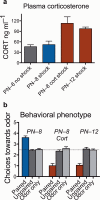Transitions in infant learning are modulated by dopamine in the amygdala
- PMID: 19783994
- PMCID: PMC2783302
- DOI: 10.1038/nn.2403
Transitions in infant learning are modulated by dopamine in the amygdala
Abstract
Behavioral transitions characterize development. Young infant rats paradoxically prefer odors that are paired with shock, but older pups learn aversions. This transition is amygdala and corticosterone dependent. Using microarrays and microdialysis, we found downregulated dopaminergic presynaptic function in the amygdala with preference learning. Corticosterone-injected 8-d-old pups and untreated 12-d-old pups learned aversions and had dopaminergic upregulation in the amygdala. Dopamine injection into the amygdala changed preferences to aversions, whereas dopamine antagonism reinstated preference learning.
Figures


References
-
- Maestripieri D, Lindell SG, Ayala A, Gold PW, Higley JD. Neurosci Biobehav Rev. 2005;29:51–57. - PubMed
-
- Sullivan RM, Moriceau S, Raineki C, Roth TL. In: Cognitive Neuroscience IV. Gazzaniga M, editor. MIT Press; Cambridge, MA: 2009. pp. 889–904.
-
- Meaney MJ, Sapolsky RM, McEwen BS. Brain Res. 1985;350:159–164. - PubMed
Publication types
MeSH terms
Substances
Grants and funding
LinkOut - more resources
Full Text Sources
Other Literature Sources
Molecular Biology Databases

